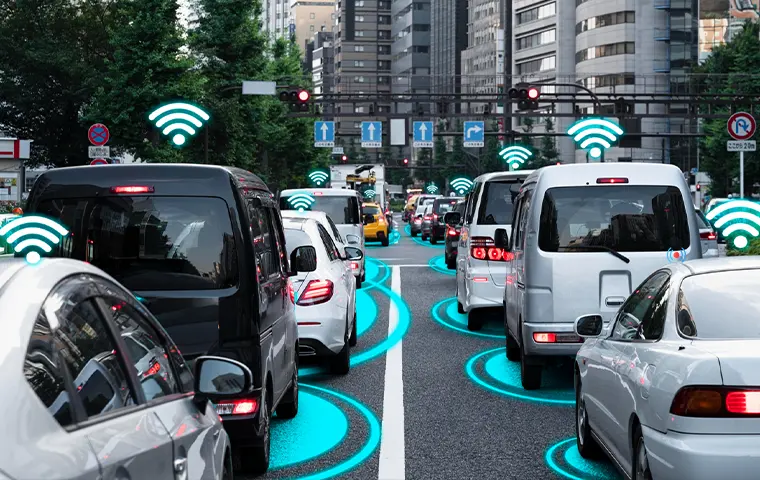Vehicle-to-vehicle (V2V) communication is revolutionizing how cars interact on the road, particularly for fleets. Think of it as cars having their own language. Through V2V, cars can share critical data like speed and location. This advanced car communication technology is vital to preventing accidents, offering a real-time way to avoid hazards. For fleet managers, V2V isn't just about safety; it's also about improving efficiency and operations. Let’s dive into the workings of V2V communication and its vital role in enhancing road safety.
Understanding V2V Communication
Vehicle-to-vehicle (V2V) communication is a cutting-edge technology that lets cars 'talk' to each other. Cars with V2V send and receive signals about their speed, direction, and location. This technology uses a special kind of Wi-Fi, designed just for cars, to share this information.
Here's how it works: Imagine you're driving, and a car ahead suddenly brakes. With V2V, your car gets a signal from that car even before you see the brake lights. This early warning can help you react faster to avoid a crash. This is just one way V2V communication safety features come into play.
V2V is especially useful for fleets. It lets drivers know what's happening with other vehicles around them, making it easier to avoid accidents. It's a crucial part of vehicle-to-vehicle accident prevention.
The goal is to make driving safer for everyone on the road. By sharing real-time data, cars can avoid collisions, and drivers can make smarter, safer decisions.
The Role of V2V in Fleet Management
Integrating vehicle-to-vehicle communication can be a game changer for fleets. Businesses are now using V2V to make driving safer and more efficient.
How is V2V Being Used Today?
Currently, V2V helps fleet vehicles communicate with each other in real-time. For instance, if one truck in a fleet slows down due to traffic, it can instantly alert other trucks from the same company. This allows following vehicles to adjust their routes or driving strategies, avoiding delays and potential accidents. Such communication is a practical example of fleet management V2V solutions in action.
How Will Fleets Use V2V in the Future?
Looking to the future, V2V's role in fleet management will only become even more significant. With technological advancements, V2V could provide more detailed data, like vehicle health information, which can predict maintenance needs. This would prevent accidents due to mechanical failures and save costs on unexpected repairs.
Additionally, as autonomous vehicles become more common, V2V will be crucial for coordinating fleets of self-driving trucks or buses, ensuring they operate smoothly and safely together.
V2V is transforming fleet management today and holds even more promise for the future. Its ability to enhance safety and efficiency makes it a valuable tool among evolving fleet technology.
Accident Prevention Through V2V Technology
Vehicle-to-Vehicle (V2V) technology can be essential for preventing accidents on the road. At its heart, V2V allows vehicles to share information that can predict and avoid collisions. This is where a key feature of V2V systems comes into play: commercial vehicle collision avoidance technology.
Let’s reflect on a previous example. If a car suddenly stops on the highway, V2V can alert following cars well in advance, giving drivers more time to react. This is crucial for commercial vehicles like trucks and buses, which need more distance to stop safely.
A feature we haven’t mentioned is intersection movement assist, where V2V warns drivers if it's unsafe to enter an intersection due to oncoming traffic.
Statistics from the National Highway Traffic Safety Administration (NHTSA) highlight the effectiveness of V2V in accident prevention. Their studies suggest that V2V can reduce certain types of crashes by up to 80%. This is significant, especially considering that commercial vehicles are often involved in accidents due to their size and weight.
If we look at the big picture, V2V is not just about avoiding accidents; it's about creating a safer driving environment. As this technology continues to evolve, its role in protecting lives and property becomes increasingly vital.
Challenges and Considerations
While Vehicle-to-vehicle (V2V) communication offers significant benefits, it's not without challenges. For V2V communication to become a reality, we must look at it from all angles.
Challenges
- Technical and Logistical Implementation
- Need for widespread adoption of compatible technology.
- Complexity and cost of integrating V2V across various vehicle brands.
- Privacy and Data Security
- Protecting sensitive data about vehicle movements and locations.
- Guarding against unauthorized access and cyber threats.
Considerations for the Future
- Advancements in Technology
- Development of more robust and secure V2V systems
- Enhancements in efficiency and functionality.
- Continuous Improvement
- Importance of ongoing research and development.
- Addressing current limitations for fuller potential realization.
With careful consideration of these challenges and a commitment to continuous improvement, V2V communication is poised to improve road safety and fleet management.
Keep Up to Date with the Latest Technology
In conclusion, V2V communication is a vital innovation for enhancing fleet safety. By enabling vehicles to share critical data, V2V prevents accidents and streamlines fleet operations. As technology evolves, the adoption and continuous advancement of V2V are essential.
Fleet managers should research V2V solutions for their fleets as an advanced fleet safety system. Azuga’s blog can help you stay informed and ahead in this rapidly advancing field. We are a leading resource committed to bringing you the latest developments in V2V technology and supporting the implementation of these life-saving systems in your fleet.








